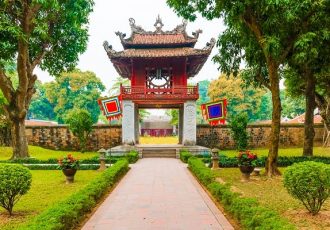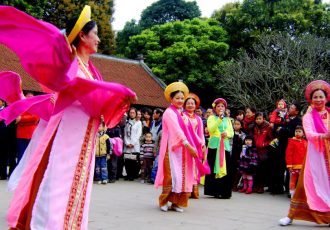Ho Chi Minh is not only a militant communist, leader, and founder of the Democratic Republic of Vietnam but is also an emblem of our homeland. He is considered “a father of compatriots”. The Vietnamese nicknamed him “Uncle Ho” to express their familiarity and their respect for him.
Built in 1973 and opened to the public in 1975, the Ho Chi Minh Mausoleum is one of Hanoi’s most visited historical monuments. It is known for honoring the national hero Ho Chi Minh who contributed greatly to the independence and reunification of Vietnam. This site is located in Ba Dinh Square where President Ho Chi Minh read the declaration of independence of Vietnam in 1945.
This final resting place of Ho Chi Minh is inspired by Lenin’s Mausoleum in Russia but has distinct Vietnamese architectural elements. The construction of this Mausoleum shows the desire of the Vietnamese to keep forever their dear father, their dear uncle. However, it was against Ho Chi Minh’s wishes. Before dying, he wished to be cremated and that his ashes are scattered at the top of three hills in the 3 regions of the country: in the North, in the Center, in the South.
Arriving at Ba Dinh Square, you can see two inscriptions “Long live the Socialist Republic of Viet Nam” and “Nothing is more precious than independence and freedom” on both sides of Ho Chi Minh Mausoleum. The gardens surrounding the mausoleum overwhelm you with the diversity of plant and flower species from different regions of Vietnam.
For the exterior, the materials are mainly used granite. And the interior is gray, black and red granite, wood and polished stone. These materials are provided by locals in all regions of our country. In Ho Chi Minh’s mausoleum, his body is preserved in the cold under a glass coffin. Honor guards are deployed inside to keep the remains of President Ho Chi Minh permanently.
At the central hall of the mausoleum, the other military honor guards are responsible for protecting “Uncle Ho’s sleep”. They rigorously apply the rules concerning dress and behavior.
So, to pass the visit without problem, first of all, you must dress decently, that is to say the shoulders covered, and with long pants or skirts going down below the knees (that is to say shorts, sleeveless shirts and miniskirts are not accepted).
Then, it is necessary to put down bags and cameras before entering, to stand in two rows and keep quiet. Children under 3 years old cannot enter.
Finally, inside the Ho Chi Minh Mausoleum, it is forbidden to smoke, photograph, record videos, and not to put your hands in your pockets. It is important to remain silent. You can observe the body of Ho Chi Minh, installed in a glass coffin, but do not stop in front of this coffin.
For restoration work and the preservation of the presidential remains, the monument is closed from October to December. Otherwise, it is usually open to the public every day from 7:30 or 8 a.m. to 10 or 11 a.m. except Monday, and Friday. Opening times depend on the season. Admission is always free.
Visitors enter to express their admiration for the common father of the Vietnamese. Visiting the Ho Chi Minh Mausoleum not only brings you an extraordinary experience but also makes you know a part of Vietnam’s history. For the Vietnamese, the mausoleum of Ho Chi Minh is also a living illustrator of national unity. It is a must-see monument when visiting Hanoi.



